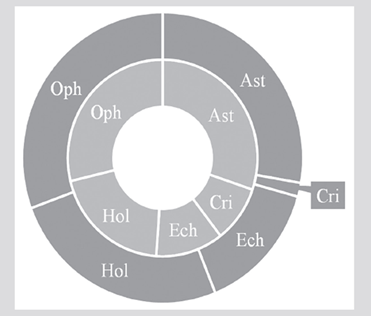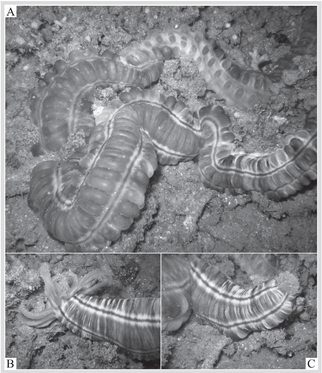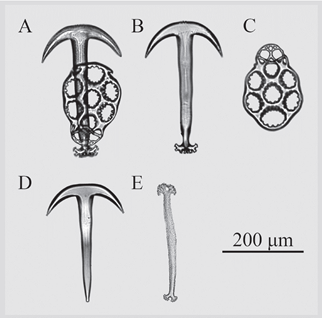The echinoderms are very important members of bottom communities. They are common inhabitants of all sorts of marine environments and can be found at all depths, being the dominant fauna in some environments (Borrero-Pérez et al., 2012; Alvarado and Solís-Marín, 2013). The number of living species in the phylum Echinodermata revolves around 7000 depending on the source: 7550 (Zhang, 2013), 6950 (Pawson, 2007), and 6828 (Roskov et al., 2019). Within this phylum, the sea-cucumbers (class Holothuroidea) comprise 20-25% of all accepted species, becoming the third richest class (Figure 1). There are 124 echinoderm species reported for the Pacific coast of Colombia (Benavides-Serrato et al., 2013), of which 34 (i.e. ~27%) are holothurians. For Gorgona Island, Neira and Cantera (2005) reported a total of 39 species of echinoderms, in which there were 11 species of sea-cucumbers (i.e. ~28%). These numbers, as compared to the reports for the Colombian Caribbean, are pale. It can be due to a real pattern or to less research effort on the Pacific coast of Colombia. Recently, Muñoz and Londoño-Cruz (2016) and Londoño-Cruz et al. (2018) reported the presence of two species of echinoids in Gorgona Island, increasing the number of known species to 41 for this protected area.

Figure 1 Proportion of species richness between the different classes of echinoderms (Ast: Asteroidea, Cri: Crinoidea, Ech: Echinoidea, Hol: Holothuroidea, and Oph: Ophiuroidea), according to Roskov et al. (2019) [outer ring] and Pawson (2007) [inner ring].
Given the above, it is highly probable that the number of species of echinoderms and especially that of sea-cucumbers in the Colombian Pacific is higher. However, the little effort put in researching this group and the lack of specialists reflects in incomplete inventories and the absence of appropriate literature for the identification of these animals in the Colombian Pacific, opening the opportunity for discoveries (e.g. Borrero-Pérez and Vanegas-González, 2019) and new reports. This might be the case of Euapta godeffroyi, a species that albeit being common, has not been officially reported in the Gorgona National Natural Park. Hence, this paper documents for the first time the presence of the lion’s paw sea-cucumber E. godeffroyi in Gorgona Island and gives the first known and confirmed locality in the Pacific coast of Colombia.
The specimen was collected manually using a diving net, on March 7, 2011, around 20 h at a depth of approximately 2-3 m in the patch reef locally known as El Arrecifito del Muelle (2,9592° N, and 78,1447° W) in Gorgona Island. This patch, like all the reefs in the Island, is dominated by corals of the genus Pocillopora. After collection, the sea-cucumber was placed on a plastic tray filled with seawater to allow it to relax and die; subsequently, it was fixed in 70 % ethanol. The specimen was deposited and tagged with the code CRE11003 in the Reference Collection of Marine Biology (Biology Department, Universidad del Valle, Cali, Colombia).
Field photographs of other specimens of this species and the external anatomy of the collected individual were compared with reports and photographs in field guides (Brusca, 1980; Kerstitch and Bertsch, 2007), regional reports (Granja-Fernández et al., 2013), and the original description (Semper, 1868). Also, tissue samples were taken and treated with sodium hypochlorite (NaOCl) to digest the soft tissue and free the ossicles, which were mounted, observed, and photographed under light microscopy (10 and 40X).
According to WoRMS (2020), the following is the current, valid, and accepted taxonomy for the specimen collected at Gorgona Island:
Phylum Echinodermata Bruguière, 1791 [ex Klein, 1734]
Subphylum Echinozoa Haeckel, 1895
Class Holothuroidea Selenka, 1867
Order Apodida Brandt, 1835
Family Synaptidae Burmeister, 1837
Genus Euapta Östergren, 1898
Species Euapta godeffroyi (Semper, 1868)
Size: Approximately 80 cm long and between 2 to 3 cm in diameter.
Habitat: sandy-coral rubble bottom next to a coral patch of Pocillopora spp.
Locality and site of collection: Gorgona National Natural Park, El Arrecifito del Muelle.
The collected specimen (along with those observed in the field) showed the typical color and coloration pattern reported elsewhere (Semper, 1868; Granja-Fernández et al., 2013): greyish-brownish body with two visible yellow lines and a brown center on the dorsal region (Figure 2A). Those lines extend from the oral, where they are more intensely colored, to the aboral part. It seems, however, that the coloration intensity is variable at the intraspecific level. The tentacles, which are used for feeding, are creamy in color and pinnated. Under conditions of stress or danger, they are retracted into the body (Figure 2B and 2C). Euapta godeffroyi’s body is extremely soft and flexible, which allows to shrink or extend its length and diameter several times. According to Brusca (1980) a specimen of around 30 cm in length, may reach up to 120 cm long when fully relaxed and extended. Finally, the body surface presents several rows of pouches-like formations, giving the appearance of corn (Figure 2).

Figure 2 Euapta godeffroyi in its natural environment. A) Corn-like surface of the body wall. B) and C) Extended and hidden tentacles, respectively.
The skeletal components of the body wall are mainly anchors with tiny ramifications at the base of the central axis and anchor plates with big perforations (Figure 3A, 3B, and 3C) and miliary granules. These types of ossicles have been already reported in different species of the family Synaptidae (Hendler et al., 1995; Borrero-Pérez et al., 2012). Two more types of ossicles were observed: one anchor-shaped with a smooth and pointing end (an early stage of the anchors) and another rod-shaped with forked branched ends (Figure 3D and 3E). It is important to note that anchors (either fully developed or in early stages) and plates were present in both the body wall and the tentacles while the rods were only observed in the oral tentacles. These last ossicles, as far as I know, have not been reported before for this species.

Figure 3 Ossicles of Euapta godeffroyii. A) Anchor with plate. B) and C) Common anchor and plate separately. D) Developing anchor with a sharp tip. E) Rod with forked endings (found only in the oral tentacles).
Euapta godeffroyi has been reported from the Indian Ocean (Tanzania, Comores, Aldabra, Madagascar, Seychelles, Republic of Mauritius, Mascarene Basin, and South Africa), the Red Sea (west coast of the Arabian Peninsula), the Central American Pacific Ocean (Panama and Costa Rica) (WoRMS, 2020), the Gulf of California (Mexico) (Kerstitch and Bertsch, 2007) and other localities along the Tropical Eastern Pacific (Granja-Fernández et al., 2013). It has also been reported from the Galápagos Islands (Ecuador) (Solís-Marín et al., 2013). In Colombia, Benavides-Serrato et al. (2013) report the presence of this species, but they do not give any reference as to the locality or the source of information. Neira and Cantera (2005) report 11 species of holothurids on Gorgona Island, without making any reference to E. godeffroyi. Benavides-Serrato et al. (2013) also reported 11 species of sea-cucumbers for the same locality, so it is highly probable that the record is not from Gorgona Island. Other authors that have worked with the echinoderms of the Colombian Pacific (e.g. Neira et al., 1992; Cohen-Rengifo et al., 2009) have not reported this species either. Given the above, this is the first official record of E. godeffroyi in Gorgona Island and, perhaps, the first confirmed and documented in the Colombian Pacific, which fills a gap in the distribution of this species in the Eastern Tropical Pacific.
The first sightings of E. godeffroyi at Gorgona Island were in 1997 when a group of researchers was working on the bioerosion process at Playa Blanca reef. More recently, this species was seen on coral rubble-sandy bottoms of reef patches (El Muelle) and fringing reefs (La Azufrada and Playa Blanca) during night dives. Euapta godeffroyi is active at night when it goes out from cover to feed. This behavior has been reported elsewhere (Brusca, 1980; Kerstitch and Bertsch, 2007; Granja-Fernández et al., 2013). During the daytime, it is normally hidden in crevices or under the reef matrix, presumably for protection. At least, in Gorgona Island, it has never been observed exposed during the daytime. This sea-cucumber shows several different reactions when disturbed, usually, it shrinks, but if handled, it can extend significantly. The collected specimen was feeding between coral rubble and loosely dispersed Pocillopora sp. coral colonies.











 text in
text in 



